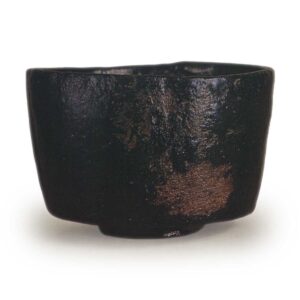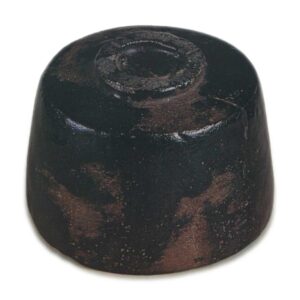

Collection: Goto Museum of Art
Height: 8.2cm
Diameter: 12.1cm
Foot diameter: 5.5cm
Height of foot: 0.6cm
What is particularly noticeable about Koetsu tea bowls is their angular shape, as seen in the “Fuji” tea bowl. This shape was not seen in Raku ware tea bowls up to that point, and so it can be said that it was Koetsu’s favorite style.
The shape of the tea bowl with the “Shichiri” mark also falls into this category, but it is closest in shape to the tea bowl with the “Kaga Koetsu” mark. It has also been said since ancient times that it is similar to the “Teppeki” tea bowl, as is written on the covering paper of the storage box, “Suki Daiichi Chin Sho Teppeki Dousaku”. This Teppeki was destroyed in the Great Kanto Earthquake of 1923, and is not currently in existence, but it can be seen well even from the photograph. The part of the rim of the so-called “ichimonji-kuchi” (a type of rim with a horizontal upper lip) that has been scraped to create a slight difference in height is a type of rim-making seen in Kaga Koetsu’s work, but there are no significant vertical scrapes on the side of the body, and only shallow scrapes are visible in places.
The body is thinly made, and there is a single vertical crack running from the rim to the foot. The black glaze that covers the surface of the vessel is highly transparent, and it has a black sheen that is reminiscent of the glaze of the Noko ware. Furthermore, the wide areas of unglazed surface on the body and the waist have an iron-like color, and the glaze has a similar tone to that of the Amagumo tea bowl. The foot is slightly wide, and the five-pronged feet on the tatami-matted surface are uneven and continuous, which is a common feature of Koetsu tea bowls. However, the underside of the footring is flat and unadorned. The inside of the bottom is also relatively plain, with the same flatness as the underside of the footring, and the center is slightly raised and higher than the rest, probably because it was pushed up by the footring during firing. The clear demarcation between the inner and outer rims of the base is also a common feature of Koetsu tea bowls of this shape, and there is a single line of broken glaze visible on the inner side of the base. The glaze on the inside is also glossy jet black, similar to that on the outside, but there is no glaze on the outside of the body.
Accessories
Inner box: paulownia wood, gold-colored lettering on the lid, “Koetsu” in gold powder
Middle box: mulberry wood, gold-colored lettering on the lid, “Shichiri Koetsu”
It is said that the box was originally owned by Shichiri Hikouemon, and that is why it bears his name, but the identity of this Hikouemon is unknown. After that, it was passed on to Iseya Seizaemon, a money-changer in Kuramae, Edo, and then to a certain person in Kanazawa. In 1892, this certain person in Kanazawa brought it to Kyoto in search of a buyer, but it is said that there were no takers. It was later acquired by Katsunori Masuda, but in 1904 it came into the possession of Katsunori’s eldest brother, Takashi Masuda, and is now in the collection of the Gotoh Museum.



